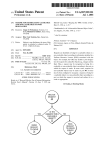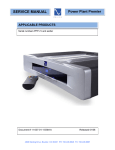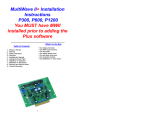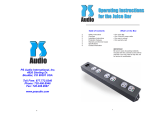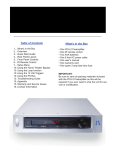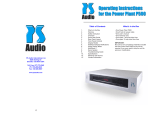Download C250 manual.indd
Transcript
Table of Contents What’s in the Box 1...What’s in the Box 2...Quick Start Guide 3...Design Overview 3...Input Gain Stage 3...Internal Power Plant 4...X1 Output Current Stage 4...Main Power Supply 4...Operation 4...Front Panel: Power 4...Front Panel: Display 5...Back Panel: Inputs 5...Back Panel: Outputs 6...Back Panel: Communication 7...Back Panel: Power 7...Specifications 8...Useful Tips 8...Warranty 8...Service Issues • One Classic 250 stereo amplifier • One 6 foot AC power cord • One user’s manual and warranty card • One pair of gloves • One spare 3 amp fast blow fuse for the regenerator board (Power Plant) and one spare 15 amp slow blow fuse for the main circuitry. • IMPORTANT: Be sure to save all packing materials included with your C250 as this will be required if you ever need to ship the amplifier for service or modification. 1 Quick Start Guide Match the C250’s positive (red) and negative (black) terminals to the corresponding speaker connections. 1. Turn off your pre-amplifier or any other piece of equipment to which the C250 will be connected. 6b. Mono Output: To connect the C250 to your speaker when in mono mode, follow the red text on the back panel. Connect your speakers’ positive lead to the left channel (+) and the negative lead to the right channel (+). 2. Ensure that you have a proper pair of audio interconnects for the input signal and a pair of speaker cables to connect the C250 to your speakers. 7. Locate the power cord supplied with the C250 and plug it into the connection labeled “AC Input.” The Classic 250 has an auto-sensing input voltage circuit, so the C250 is virtually plug-and-play in this regard. For more information on input AC voltage, see pages 7. 3. Unpack the C250 and place it on a smooth surface. (As with any amplifier it is not advisable to place on carpet or other airflow restricting materials.) 4a. Stereo Input: Choose either the single-ended (RCA) or balanced (XLR) input connections on the back of the C250. There is a selector switch for each channel to activate the connector you have chosen. Only one type of input, RCA or XLR, will work at a time. Be sure to set both the left and right channel to either RCA or XLR input. 8. Plug the male end of the power cord into your wall receptacle. This automatically engages the regenerator and voltage gain stage. The meter display will light up in yellow for a period of 17 seconds during this intial activation phase. The Power button is purposefully kept inactive during this time. 4b. Mono Input: Follow the red text on the back of the C250 for mono setup. Set the rear panel selector switch on the back panel to “Mono.” This deactivates the right channel input connectors. Use the left channel input connectors to run your C250 in mono. Don’t forget to set this input for RCA or XLR. 9. After 17 seconds and the meter display has gone dim, turn on the C250 by pressing the button in the center of the chassis, below the meter display. Also, turn on the pre-amplifier and any other piece of equipment needed to operate your system. 10. The C250 will power up in standby mode for 40 seconds. During this period, the front panel meter will light up in yellow and the PS logo in blue, indicating the standby mode. 5. Connect the outputs of your pre-amplifier or source equipment to the inputs of the C250 according to the instructions in 4a for stereo or 4b for mono. 6a. Stereo Output: Connect your speakers to the C250’s output terminals, labeled “Right” and “Left.” Be sure to connect the polarity of the speaker cables correctly. 11. After 40 seconds the meter will light up in blue. The C250 is now fully operational and ready to drive your speakers. Start the music and enjoy!! 2 Design Overview The Input Gain Stage This critical element is, in large part, responsible for the way the amplifier sounds. By carefully tuning the audio parameters of the input gain stage we can tweak and play with the amplifier until it sounds absolutely musical. Based on the classic lines of the P600 Power Plant, this is built in true ‘battleship’ fashion. This 95 pound audio sculpture is simply magnificent in its build quality and attention to detail. In the Classic 250, the input gain stage consists of two gain blocks: a zero feedback JFET input stage and a zero feedback bipolar stage. Both of these stages are fully differential. The side heat sinks are on hinges and fold down to expose the C250’s circuitry for easier access to the internal circuitry. No expense has been spared on the most visible evidence of the Classic approach to power amplification. The look exudes finesse. The input gain stage runs at extremely high voltages. In fact, the 200 volts used by this stage is one of the reasons why the C250 sounds so open and musical even during the loudest passage. The front panel is a nearly two inch thick combination of extruded aluminum panels tied together both top and bottom with one inch slabs of hand finished aluminum. The entire assembly is then melded together to form the luscious curves you see. All the C250’s 30 dB of gain is produced by the input gain stage. This stage is completely independent from the output current gain stage. The input stage is fed by its own regulated power supply that gets its power from a built in Power Plant. Parts quality is second to none. Low ESR capacitors, each with film and foil bypass capacitors, 1% resistors throughout, 40 hand selected high current bipolar output devices, two custom wound and individually serialized 800VA toroidal transformers, and the front panel meter is a custom manufactured replica of the classic Simpson volt meters of years ago. Nothing has been spared in the Classic 250. Because the input gain stage has no interaction with the output stage, the Classic 250 sounds the same on virtually any loudspeaker load. The Internal Power Plant Our Power Plant AC regenerators have revolutionized power within people’s homes forever. Now it is available in a specially tuned version designed to enhance the performance and long term reliability of the C250. The design idea behind the Classic 250 is based on the marriage of four discrete and independent systems. The fact that each of these systems is completely independent both physically and electrically from the other is one of the keys to the Classic 250’s sonic success. The 40 watt Power Plant inside the C250, with its own discrete and custom wound toroidal transformer, independently powers the entire input gain stage and was hand tuned to maximize the amp’s performance. The four sections are: • The input gain stage • The internal Power Plant • The output X1 stage • The main power supply After hours of listening tests we finally settled on one of our original Power Plant favorites, 120 Hz sine wave. This provides the cleanest and most open sound for the 3 Operation C250 amplifier, producing a much more rich and open sound. Front Panel: Power The front panel of the C250 was designed to bring both a level of elegance and simplicity into your system. The power button (on/off) is located directly in the center, below the meter display. Having a Power Plant built into the Classic 250 to regenerate a clean AC signal for the input gain stage is one of the factors that sets this amplifier apart. It is worth noting, however, that the Power Plant is only regulating the input stage. Therefore, additional levels of AC regeneration can be implemented to improve the amplifier as a whole, for example with a P1200 Power Plant. In other words, a clean, well regulated AC power line will make a difference with the C250. Plugging the C250 into the wall activates both the regenerator (power plant) and voltage gain (input) stage. The meter display will light up in yellow for 17 seconds while these two circuits activate, during which the power button will not respond to your touch. These sections are kept powered up at all times. After the initial 17 second activation period, the yellow light in the meter display will go dim. Still, the output section has no power. The X1 output current stage Typically the output stage of a power amplifier is tied to the input stage and together they form a “team” to produce the power. Not so in the C250. This revolutionary and one-of-a-kind current stage is an absolutely separate and independent standalone current converter. It has its own power supply, its own feedback loop and is physically separated from anything else in the amplifier. Pressing the power button will initiate the power up sequence, which lasts for 40 seconds. During this period, the meter will light up in yellow and the PS logo in blue, indicating the standby status. It is not advisable to try and play music during this period. The C250 can handle loads less than 2 Ohms and still breathe easily. To accomplish this we incorporated 20 high current output devices per channel. Each of the 40 output devices in the Classic 250 can handle 30 amps of power. The C250 becomes fully operational once the meter display lights up in blue. This indicates that the C250’s output stage is engaged. Once fully powered up, pressing the power button again will turn the output stage off. The main power supply Obviously the purpose of a power amplifier is to generate power. Pure, clean and musical power that has no limitations. Front Panel: Display The front panel display window in the C250 contains an analog meter that reads several useful statistics. Inside the C250 are two completely independent toroidal transformers and power supplies and a short signal path to maintain the highest possible power quality. The top line, labeled “DCV,” is a representation of the voltage that is available to the output stage. There is a direct relationship between this value and the input AC voltage. For example, feeding the C250 with 120 volts should present a DCV value of 80 volts. Each of the two toroidal supplies is a monstrous 800VA transformer that is housed under its own chassis, isolated from the main body. These transformers feed a robust 80,000 mFd’s of energy storage. 4 The center line, labeled, “%,” presents the same information as above, but displayed as a percentage. Therefore, a 120 volt input should read 100%. Stereo Input: Whether you are using a pre-amplifier or a source component with a built in processor, you will want to ensure that the left output from that equipment matches the “Left” of the C250 and likewise for the “Right.” Be sure to use the inputs in matched pairs for example, use both RCA inputs or both XLR inputs, but never one of each. The bottom line, labeled “Energy Storage,” indicates the accepted voltage range to achieve normal operation. During loud passages, or if your AC line temporarily sags, you may witness some degree of fluctuation in the meter. If the needle consistently resides somewhere outside the accepted Energy Storage range, you may elect to have an electrician check your line voltage to ensure proper operation of the Classic 250. Mono Input: If you intend to use your C250 in mono mode, which will require one Classic 250 amplifier per speaker, you must first switch the input selector on the right channel to Mono. This deactivates the right channel input. The left channel connectors are now used for making input connections while in mono. These instructions are also indicated on the back panel in red text. As discussed in the Front Panel: Power section, a yellow meter indicates standby and a solid blue meter indicates full operation. If the amplifier experiences a problem, for example a short circuit or over-voltage, the C250 will go into its fault protect mode. This status is indicated by the meter display flashing blue. If you ever encounter this situation with your C250, first check to make sure that all connections are seated properly. Then turn off and unplug the C250 from the wall, allowing its circuitry to reset and power it back up. If the amplifier is still indicating the fault mode, please refer to the back of this manual for service. Back Panel: Outputs There are four pairs of speaker terminals on the back of the C250. Two pairs are situated on the left channel side and two pairs are situated on the right channel side. There are two pairs of outputs per channel for easier bi-wire connections to your loudspeakers. Both pairs output the exact same signal for their respective channels, right or left. The C250 uses WBT five-way binding posts able to accept a spade, banana, spade and banana, pin or straight wire. Back Panel: Inputs There are two sets of inputs to choose from, single-ended (RCA) and balanced (XLR). The single-ended RCA connections are a very high quality, gold plated connector designed specifically for PS Audio components. The balanced XLR connector is easily identifiable as the larger connector with three individual pins. The C250 is a fully balanced design, thus use of the balanced XLR inputs is the optimal choice. 5 Stereo Output: The positive terminals are indicated by a red connector and (+). The negative terminals are indicated by a black connector and (-). Connect the left positive (red) of the C250 to the positive (red or +) of your left speaker cable and connect the left negative (black) of the C250 to the negative (black, white or -) of your left speaker cable. Do the same for the right side terminals of the C250 and your right speaker. Be sure to hook-up your speaker(s) in phase with the C250; it should be positive to positive and negative to negative. entiate between high frequency and low frequency inputs). With two mono C250s per speaker, one amplifier would be used for low frequencies while the other would be used for the high frequency connection to your speaker. Back Panel: Communication The C250 includes the PS Buss, which allows for a sophisticated method of communication between PS gear that supports this protocol. Each PS product that has the PS buss installed can communicate with any other similarly equipped PS product. Mono Output: Hooking up a speaker to a C250 set for mono is slightly different. As with the input connectors, follow the red text to determine the appropriate connections. The PS buss allows you to turn on and off the C250 from another PS component that is set as the master device. To place the C250 on a network, you will need to have it connected to another piece of PS equipment that is properly interfaced to a CE network. In mono, the positive lead is established with the (+) from the left channel and the negative lead comes from the (+) on the right channel. Either the top or bottom connectors can be used, once again for easier bi-wire hook-up. The C250 can be assigned as single or as one of many power amps in the system. You can sequentially turn the unit on or off from the push of a single button. Other: Aside from standard stereo or mono applications, the C250 can also be applied in bi-wiring or bi-amping configurations. To bi-wire, simply add a second set of speaker cables to the second set of output binding posts and hook-up your speakers according to that manufacturer’s recommendation. Also included on the back of the C250 is a 12-volt DC trigger. This device has been provided for your convenience to incorporate the C250 into other types of automated systems. This 12-volt trigger is an input trigger and will respond to an external signal from 5-12 volts. For bi-amping, you may use one C250 (in stereo) or two C250s (in mono) to drive each of your speakers. With one stereo C250 dedicated per speaker, the left and right designations on the back of the C250 can be substituted for “high” and “low” (or whatever correlates to the description your speakers use to differ- Back Panel: Power The C250 is equipped with the standard, internationally accepted 15 amp IEC. This device is labeled, “AC input.” With the supplied power cord, or with another high-end after market cable like the PS Audio Lab Cable II, connect the C250 to a power source. 6 The C250 is internally equipped with a PS Audio Power Plant. This circuit was specifically tailored for the C250 input stage. The primary function of this power plant is to regulate and optimize the power line signal for the input stage, however you may still choose to plug the C250 into a PS Audio P1200 Power Plant to obtain additional levels of enhancement. Otherwise, simply connect the C250 directly into your wall receptacle. The C250 is equipped with a 3 amp fast blow fuse to provide protection for the regenerator (power plant) board. This fuse can be located where it says, “Regenerator Fuse.” There is another fuse to provide protection for the main amplifier circuitry, which has a 15 amp slow blow rating. This fuse can be located where it says, “Main Fuse.” Specifications Stereo 8 ohm power.........250 watts RMS Stereo 4 ohm power.........500 watts RMS Mono power...................1,000 watts RMS You will find two spare fuses along with this user’s guide should you need them. To obtain specific information on how to replace a fuse, or more importantly to determine if the fuse needs replacing, refer to the service section at the end of this manual. THD+N.............................0.2% at full rated power into 8 ohms, 20 Hz - 20 KHz The C250 is capable of handling either 100-120 volts AC input or 220-240 volts AC input. The input AC circuitry in the C250 is auto-sensing. Therefore, the Classic 250 will automatically recognize the correct input voltage and make the appropriate internal adjustments to function properly. There are no manual selections or switches to be made by the user to select input voltage. Max Input Level...........................1.5 Vrms Frequency Response................+/- 0.1 dB 10 Hz - 22kHz Dynamic Range..............................111 dB Max Output Level......................45.5 Vrms Max Gain...........................................30 dB Max Power Consumption........1600 watts Input impedance......................100 K ohm Input connections.......pair each balanced (XLR) and single-ended (RCA) Output connections.............2 pairs 5-way binding posts per channel Dimensions...............17” W x 9” H x 20” D Weight..............................................95 lbs 7 Useful Tips Service issues Should your unit ever require service or if you have any technical questions about the C250 (for example, how to replace the fuse or what a flashing blue display means), you must either contact your dealer (PS Audio if purchased direct) or your PS Audio distributor. No equipment will be received at our service facilities without an attached RA number. Speaker placement Speaker placement, particularly in a twochannel setup, can be a critical element in system performance. Once you have installed the C250 in your system, we would encourage you to re-evaluate the loudspeaker’s positioning with respect to toe-in, distance from the rear wall, and distance from each other. To look for additional tips that may improve your system, you can go to the PS Audio web site at http://www.psaudio.com/ toolbox.asp and click on to the “Tips & Tricks” section. There you will find a number of informative articles on speaker placement, system tuning and much more. If purchased through an authorized PS Audio dealer or distributor, the RA number must be obtained by the dealer or distributor. If the product was purchased from PS Audio direct, this can easily be obtained by calling PS Audio at 720-406-8946 or by contacting us via email at customerservice @psaudio.com. Warranty inside the U.S. and Canada PS Audio’s warranty is 3 years parts and labor, from the date of original purchase, and is fully transferable. This means that we warranty the product itself regardless of ownership, new or used. For the official warranty statement please refer to the warranty card included with this user’s manual. Warranty outside the U.S. and Canada PS Audio has authorized distribution in many countries of the world. In each country, the authorized importing retailer or distributor has accepted the responsibility for warranty of products sold by that retailer or distributor. Warranty service should normally be obtained from the importing retailer or distributor from whom you purchased your product. In the unlikely event of service required beyond the capability of the importer, PS Audio will fulfill the conditions of the warranty. Such product must be returned at the owner’s expense to the PS Audio factory. Contact your PS Audio distributor or the PS Audio customer service department for more information. PS Audio International, Inc. 4824 Sterling Dr. Boulder, CO 80301 PH: 877-772-8340 FAX: 720-406-8946 www.psaudio.com 8









